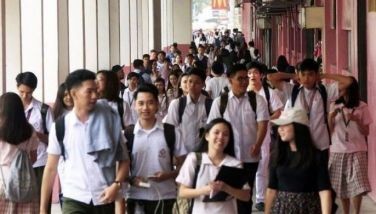Arts and culture take center stage in FEU
MANILA, Philippines - Since its establishment in 1928, Far Eastern University has been championing the holistic development of its students through the promotion of the arts and the celebration of diverse cultures from the Philippines and around the world. Its flagship campus in Manila, designed by National Artist for Architecture Pablo Antonio, Sr., is a UNESCO Asia-Pacific Heritage Site. As a living museum, art and architecture co-exist, not behind glass to be seen from a distance but in the midst of daily academic life.
“We hope to enrich the university experience of our students by inculcating in them the value and necessity of the arts and culture†says Martin Lopez, director of FEU’s President’s Committee on Culture (PCC). “Every month during the school year, we present programs that not only showcase our students’ talents but also those of established local and foreign artists with the goal of building awareness, appreciation and audiences for the arts.â€
Led by the PCC, the 2014-15 academic year is poised to celebrate the 65th anniversary of the historic FEU Auditorium with the theme of “Discovering One’s Identityâ€. FEU’s cultural calendar opens with Musica FEUropa 6, an annual, nationwide choral competition held in cooperation with the European Union that highlights the richness of both Filipino and European culture and heritage.
FEU will premiere the musical adaptation of the popular 19th century novel by Modesto de Castro, “Urbana at Felisaâ€, which will be staged on September 12 by the FEU Theater Guild (FTG) in commemoration of the work’s 150th anniversary of publication. Published in 1864, the novel emphasized Christian values and standards of behavior, and served as a guide on proper conduct especially for women. The play will open a national conference organized by FEU entitled “Ang Tinig at Himig nina Urbana at Felisa: Iba't-Ibang Dulog at Pagbasaâ€.
The FTG, one of the oldest drama groups in the University Belt, continues its 80th anniversary this year with the production of “Makikitawag Lang Ako,†an adaptation of Gabriel Garcia Marquez’ “I Only Came to Use the Phoneâ€. Adding to the long list of productions by the FTG which was founded by the late Sarah Kabigting Joaquin, this season opener revolves around a woman who, while seeking help for her broken car is fetched by a bus heading to a mental institute. She is mistaken for a patient and unfortunately, never gets to leave.
“Each year, we see to it that we have a wide range of cultural programs for our students. This is not just to bring the arts closer to the student community, but also to help those involved in the cultural groups to develop skills that they may not necessarily learn in the classroom, such as collaboration, innovation and self-esteem,†explains Lopez who also leads the management of FEU’s cultural groups, the Bamboo Band, Chorale, Dance Company, Drum and Bugle Corps, and the FTG, in addition to the FEU Guides, who conduct tours of the Art Deco campus in Manila.
The University boasts of a rich history of arts and culture and is a haven for art enthusiasts. The FEU campus in Manila is home to the largest ensemble of art deco architecture that survives in the city today and to rare works by National Artists for visual arts Fernando Amorsolo, Vicente Manansala, Carlos “Botong†Francisco, Cesar Legaspi and Napoleon Abueva. The FEU Auditorium, served as the country’s cultural center in the 1950s with all the major theater, ballet, opera and classical music events happening on its stage, a legacy which the University continues through its PCC.
FEU has always been a staunch supporter of arts and culture, putting it at the forefront of student development. Its founder Dr. Nicanor Reyes, Sr. recognized the importance of arts programs in the students’ university experience, as he led and supported the establishment of the university’s cultural organizations as far back as the 1930s. He believed in a well-balanced student, one who is competent in academics, athletics and the arts.
“We encourage our students to join our cultural groups and develop their artistic talents. We offer full and partial scholarships to qualified members of any of FEU’s five cultural organizations who excel in their academic and artistic requirements†says Lopez.
FEU’s arts and culture program exemplifies the findings of researches around the world, including that conducted by the University of California Los Angeles showing that student engagement in the arts is linked to higher academic performance and can help improve critical thinking and problem-solving skills. Another study by the University of Sydney reveals positive effects of student participation in arts programs, such as self-esteem, life satisfaction and a sense of meaning and purpose. Beyond its students, faculty, staff and alumni, FEU extends its arts and culture programs for the community at large, most, if not all of which, are always free and open to the public.
- Latest
- Trending



























